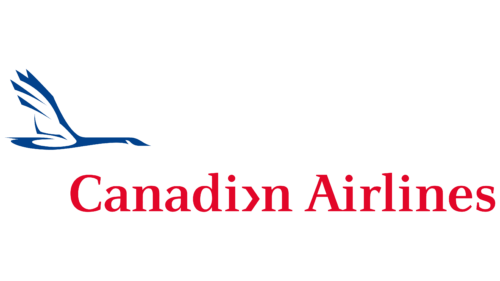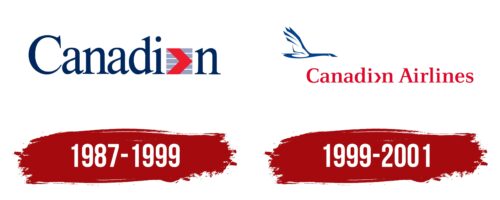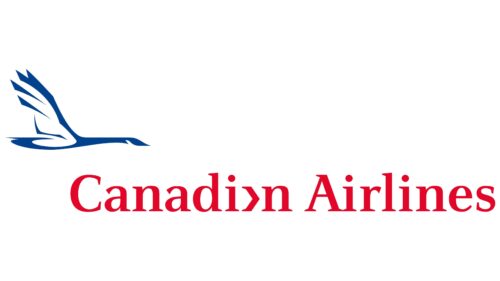The Canadian Airlines logo is the epitome of its philosophy and values. The “Canadi>n Airlines” logo lettering is simple and concise, but the arrow sign instead of the letter “a” gives it a special symbolic meaning. This sign means that the company is always ready to move forward to new horizons to follow the path of constant development and progress. Red is the color of energy, passion, and courage, which match the company.
A bird in the form of a flying goose is the logo’s main symbol. She strongly symbolizes freedom and the desire for travel and new horizons. In Canadian Indian culture, the goose is considered a symbol of wisdom and insight. The blue color of the bird indicates calmness and reliability, which are important for a company that strives to provide its passengers with safe and comfortable flights.
Overall, the Canadian Airlines emblem embodies the principles of a company that strives for innovation and development but at the same time attaches great importance to the comfort and safety of its passengers.
Canadian Airlines: Brand overview
| Founded: | March 27, 1987 – January 1, 2001 |
| Founder: | Canadian Airlines Corporation |
| Headquarters: | Calgary, Alberta, Canada |
The Canadian government founded Trans-Canada Air Lines (TCA), the nation’s flag carrier, in 1937, marking the beginning of Canadian Airlines. TCA, which was eventually renamed Air Canada, controlled the Canadian airline industry for many years.
The Canadian government started deregulating the airline sector in 1978, allowing competitors to enter the market. As a result, several new airlines were formed, notably Wardair, Pacific Western Airlines (PWA), and Canadian Pacific Air Lines (CP Air).
PWA bought rival CP Air in 1987 amid financial troubles and market consolidation. The two airlines later combined to become Canadian Airlines International. As a result, the company emerged as the biggest private airline in the nation and Air Canada’s primary rival.
The consolidation proceeded when the company bought Wardair, a significant Canadian airline, in 1989. This acquisition greatly expanded the carrier’s foreign route network, particularly its transatlantic lines to Europe.
The company launched a massive initiative to increase the size of its fleet and route network at the beginning of the 1990s. The airline placed significant orders for brand-new Airbus A320, Boeing 737, and 767 aircraft. South America, Asia, and Europe all have new access points available. The company operated flights to over 105 destinations globally at its height.
However, by the mid-1990s, the airline faced serious financial difficulties due to its rapid expansion and fierce competition from Air Canada. The business was losing money, and its debt was growing. Restructuring and cost-cutting attempts did not produce the expected outcomes.
In 1996, American Airlines invested $246 million in the company and purchased a 25% share. This prevented the airline from going bankrupt, but it did not address the underlying problems with profitability in a cutthroat industry.
By the late 1990s, the company’s financial condition had become dire. The corporation nearly declared bankruptcy, with debts totaling more than $3 billion. Under these conditions, the carrier’s management started looking for possible purchasers.
The primary rival, Air Canada, made an acquisition offer for the company in 1999. Regulators, however, first halted the deal because they were worried about excessive market consolidation. The Canadian government only authorized the transaction in December 1999, when the airline was in danger of filing for bankruptcy.
It took almost a year to incorporate the airline into the Air Canada organizational structure, which started in 2000. The last flights operated by the airline under that brand were on June 26, 2000. Beginning on June 27, 2000, all flights were operated under the Air Canada code, and the brand was completely discontinued in January 2001.
Meaning and History
What is Canadian Airlines?
This was the largest private airline in Canada, based in Calgary, Alberta. The company stood out for its extensive route network, covering domestic destinations and international flights to Europe, Asia, and South America. It pioneered the implementation of a computerized ticket booking system in Canada, revolutionizing the ticket sales process in the country. The company’s uniqueness lay in its innovative Canadian Plus loyalty program, which allowed passengers to earn miles for flights and purchases at partner stores and hotels.
1987 – 1999
1999 – 2001
Canadian Airlines color codes
| Spanish Red | Hex color: | #e20628 |
|---|---|---|
| RGB: | 226 6 40 | |
| CMYK: | 0 97 82 11 | |
| Pantone: | PMS 185 C |
| Safety Blue | Hex color: | #02428c |
|---|---|---|
| RGB: | 2 66 140 | |
| CMYK: | 99 53 0 46 | |
| Pantone: | PMS 7687 C |






